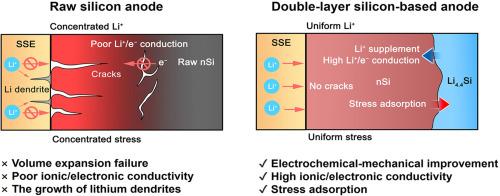An electrochemical-mechanical synergistic regulation by constructing a double-layer fully active silicon-based alloy anode in sulfide all-solid-state batteries
IF 8.3
1区 材料科学
Q1 MATERIALS SCIENCE, MULTIDISCIPLINARY
引用次数: 0
Abstract
Silicon anode is one of the most promising anode materials for sulfide all-solid-state batteries (ASSBs) due to its high theoretical specific capacity of up to 4200 mAh g−1. However, raw silicon anodes suffer from their intrinsic limitations, including low ionic and electronic conductivity, as well as significant mechanical stress arising from large volume changes during cycling. These factors contribute to the poor cycle life of silicon-based ASSBs. Herein, a double-layer structure composed of lithium-rich Li4.4Si alloy layer and nano silicon (nSi) anode layer, is proposed to address these issues. The double-layer structure enriches Li4.4Si on the current collector side, serving as conductive lithium reservoir that improves the Li+ transport and electron conductivity. The low elastic modulus of Li4.4Si alleviates the mechanical stress induced by volume changes in the silicon upper layer. Finite element analysis indicates that the double-layer design reduces interfacial stress by three times, ensuring effective interfacial contact and providing abundant Li⁺ transport pathways. The ASSBs employing the double layer silicon anode coupled with LiNi0.8Mn0.1Co0.1O2 (NCM811) cathode exhibit exceptional cycle stability, achieving the capacity retention rate of 86.50 % after 200 cycles at 0.5 C. Furthermore, a remarkable cell-level energy density of 308.04 Wh kg−1 was achieved at a high loading of 3.38 mAh cm−2. The double-layer Li4.4Si/nSi anode can be incorporated into pouch cells, demonstrating good cycling stability. This design holds significant potential for the transition of sulfide ASSBs from laboratory-scale development to industrial applications.


通过构建硫化物全固态电池中的双层全活性硅基合金阳极实现电化学-机械协同调节
本文章由计算机程序翻译,如有差异,请以英文原文为准。
求助全文
约1分钟内获得全文
求助全文
来源期刊

Acta Materialia
工程技术-材料科学:综合
CiteScore
16.10
自引率
8.50%
发文量
801
审稿时长
53 days
期刊介绍:
Acta Materialia serves as a platform for publishing full-length, original papers and commissioned overviews that contribute to a profound understanding of the correlation between the processing, structure, and properties of inorganic materials. The journal seeks papers with high impact potential or those that significantly propel the field forward. The scope includes the atomic and molecular arrangements, chemical and electronic structures, and microstructure of materials, focusing on their mechanical or functional behavior across all length scales, including nanostructures.
 求助内容:
求助内容: 应助结果提醒方式:
应助结果提醒方式:


